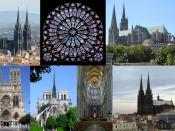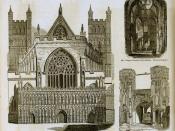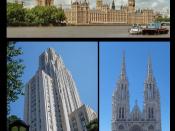The church in the Middle Ages was a place that all people, regardless of class, could belong to. As a source of unity, its influence on art and architecture was great during this time. As society drew away from the feudal system of the Romanesque period, a new spirit of human individualism began to take hold; alas, the birth of Gothic. Here, the Church became a place where humanity became more acceptable, becoming the ideal place to visualize new ideals. The beauty and elegance of Gothic architecture is depicted most in the great cathedrals of the 12th, 13th and 14th centuries--St. Denis, Notre Dame, Chartres, Salisbury, Durham, Amiens, and more. The experience of looking at one of the great gothic cathedrals is to look up towards God. Indeed, most Gothic structures emphasize the vertical, drawing one's eyes upwards toward the heavens with the awesomeness of God (Gothic Architecture, 2006).
The León Cathedral is a magnificent example of the classical Gothic architecture that spread throughout Europe during the thirteenth and fourteenth centuries.
It takes the form of a Roman cross, with a nave and two aisles, as well as a transept (León Catedral, 2006). Its structure shows the influence of the cathedrals of Rheims and Amiens. The homogeneous style, purity of its lines, and the surprising dimensions of its stained glass windows set into a relatively small surface of walls, have all served to bring about its receiving the title of "the Beauty of Leon". It was commissioned by Bishop Manrique de Lara and had Maestro Enrique and Juan Perez for its architects (Archivo, 2006).
Saint Patrick's Cathedral, the seat of the Roman Catholic archbishop of New York, is an example of the decorated and geometric style of Gothic ecclesiastical architecture which prevailed in Europe from 1275 to 1400, and of...



Decent
Great start...I would expand this it is a worthy topic.
4 out of 5 people found this comment useful.